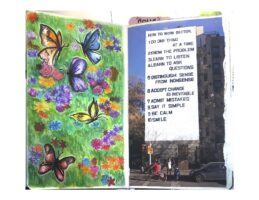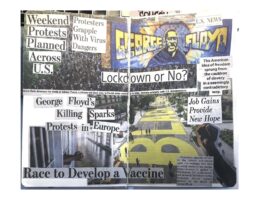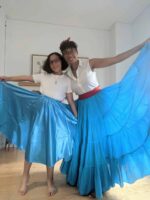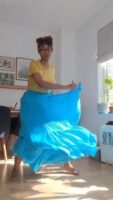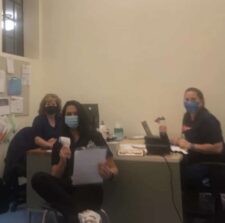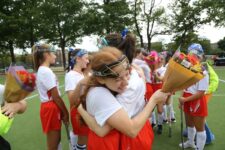From mid-September to mid-October, we celebrate Latinx Heritage Month. The month aims to pay tribute to the culture and contributions of Latinx people, and ECFS honors the month across its four divisions. Here, we look at what Latinx Heritage Month looks like at Fieldston Upper, Fieldston Middle, Ethical Culture, and Fieldston Lower.
At Fieldston Lower, 4th and 5th Graders in Cristina Mella’s Spanish classes have spent the month getting an introduction to different Spanish-speaking countries and learning about their inhabitants’ culture. Learning has leaned heavily on the artistic catalogue of each country: music, dance, and the like feature prominently in each class.
On a Friday toward the end of Latinx Heritage Month, a 4th Grade pod closes out their second fully on-campus week. Mella’s afternoon class — conducted entirely in rapid Spanish — is an introduction to the shift to more detailed work on individual countries. Mella asks the students to name countries that speak Spanish around the world, and the students yell out their answers. Mella pivots to a video called “Paises de Habla Hispana,” that names Spanish-speaking countries in song, listing the 21 countries over an infectious drum beat.
Next, it’s time to place countries on a map. Over the course of the month, students have learned not just culture, but geography as well, and they take turns dragging the names of countries onto a blank map shown on the classroom’s smart board. Mella asks for each country’s capital, and the group responds: ¡Havana! ¡San Juan! ¡Santiago!
Once the map is filled out, the students turn their attention to reviewing the month’s learnings on Latinx heritage in an online game of Kahoot — and they are thrilled. The music kicks up and the students dance in their seats, pulling out their computers to play the game.

“¿Cuántas personas (más o menos) hablan Español en el mundo?” the game asks. The students rush to answer (a little under 500 million people speak Spanish worldwide), and delight in seeing the rankings of who answered the fastest.
Examinations of the world as a whole are critical to the curriculum, but so too is the need for students to see their learning in their own community and everyday experiences. “¿Quien habla español en la escuela?” Mella asks, and the students rattle off members of the Fieldston Lower community — faculty and staff — who speak Spanish. Mella also points out the diverse heritage of Fieldston Lower’s Spanish-speakers, naming different countries of origin around the world. It’s a nod to both Latinx Heritage Month and the School’s progressive approach to language instruction: the education is not abstract; it’s relevant to students’ lives.

Class ends with a typical exploration of Latinx culture: Mella puts on a dance video and the students find their places next to their desks. “La Gozardera” by Cuban duo Gente de Zona starts playing, and the students follow the dance steps on screen. By the time class ends, students have bounced from geography to ancestry to culture — honoring Latinx Heritage Month through the School’s immersive and experiential approach to language instruction.
At Fieldston Middle, honoring Latinx culture, heritage, and history happens throughout the year, spearheaded by the Latinx affinity group, which is now in its third year, and is led by 7th Grade Dean and Math Teacher Elizabeth Flores and Ethics and Technology Integrator Ingrid Sabogal.
In past Latinx Heritage Months, the affinity group has hosted Town Halls for the Fieldston Middle community. For the first year, the Town Hall focused on terminology, history, and experience. Members of the affinity group asked their classmates what they knew of terms like “Latinx” or “Hispanic,” and explained the differences. A conversation of history included Indigeneous roots, African roots, and Spanish roots, and how that coalesces into Latinx heritage. They also shared with their classmates “what it’s like to be Latinx,” Flores says, and focused on the myriad faces of a Latinx identity. At the Town Hall, they showed images of different people, asking students to thumbs up or thumbs down if they thought the person was Latinx. “It was really interesting for the student body to debunk some of the ideas and preconceptions people have,” Flores says.
Fieldston Middle also used large scale installations to highlight achievements coming out of the Latinx community. Flores and Sabogal created an enormous periodic table of Latinx artists, musicians, scientists, athletes, activists, and more, exposing passersby to the variety of contributions Latinx people have made to society. Last year’s Town Hall focused on people’s stories, especially within the ECFS community. Affinity group members interviewed people who identify as Latinx, finding commonalities and nuances in their experiences. Flores points out that many members of the Facilities and Dining staff identify as Latinx, and that honoring their contributions to the School is paramount, regardless of Latinx Heritage Month. “They really take care of us. It’s the people who are ensuring — especially now — that we’re fed safely, ensuring everything is cleaned and sanitized for us and that health is the utmost priority,” she says.
It was really interesting for the student body to debunk some of the ideas and preconceptions people have.
The Fieldston Middle Latinx affinity group works year round to honor the Latinx experience — from Town Halls to organizing a necessities drive for Puerto Rico in the wake of devastating earthquakes — and together grapples with increasingly hostile news. “There have been so many moments that feel like injustices in our community,” Flores says. This year, the affinity group looks to meet together remotely, continuing the work they’ve started in the previous two years.
At Ethical Culture, 5th Grade Teacher Kimberly Tan and Spanish Teacher Joan Singer have collaborated on a unit that explores and celebrates Central America. Last year, the two teachers discovered that while many students are familiar with — and may even have visited — countries like Honduras or Costa Rica, they have difficulty situating them on a map. As a result, Tan and Singer designed a lesson that would teach Spanish vocabulary while integrating Central American culture and geography.

This year, with Tan teaching on campus and Singer teaching remotely, the teachers worked together after school hours to figure out how to bring their lesson online. Tan created worksheets providing information about Central American countries, while Singer created vocabulary flash cards. During their classes with Singer, students read the flash cards, which show words and phrases like “Católicos” or “Canal de Panamá,” and attempt to recall the relevant facts they’ve learned — doing their best to speak entirely in Spanish.
For Singer, contextualizing Spanish within specific countries and places helps students understand that Spanish is not just a collection of words and phrases they learn in school, but a rich language tied to a “culture and real people and real expressions and real food.”
At Fieldston Upper, Lorena Rodas-Ramirez strives to add nuance to the festivities of Latinx Heritage Month by investigating the complex — and at times painful — history of Latinx communities. In her Spanish classes, as well as her history elective this semester, she challenges students to not only grapple with the oppression that Latinx people have faced and continue to face, but also to celebrate their strength, resilience, resistance, and success in spite of oppression.
In Spanish for Heritage Speakers I, Rodas-Ramirez tasked her students with exploring their families’ immigration stories. Many students interviewed their mothers or grandparents, whose responses revealed the complicated layers of loss, uncertainty, and hope that often accompany coming to the United States. Immigration — and especially how the United States legal system antagonizes and dehumanizes immigrants from Latin American countries — is a theme of vital importance to Rodas-Ramirez; during last year’s Latinx Heritage Month assembly, titled “An Ongoing Genocide: Indigenous and Marginalized Communities in the Americas,” she and her students discussed the horrors of family separation, and Rodas-Ramirez asked for a minute of silence as she read aloud the names of seven children who had passed away while in detention.
To ground Latinx Heritage Month not only in centuries-old customs and traditions, but also in current events is critical to normalizing the Latinx community. In Spanish for Heritage Speakers II, Rodas-Ramirez turns her students’ attention to a topic of immediate relevance: the COVID-19 pandemic. “Many Latinos, particularly those undocumented, are considered essential workers, but they are also seen as expendable by the system,” she explains. “In New York City, Latinos were the group most affected by the pandemic.” Students began the unit by reflecting on their own experiences with the pandemic. For their current project, students will interview six people within the Latinx community on their experiences with COVID-19, centering voices that have not received enough attention.
In her reworking of the Modern Latin America History elective, which she has titled Nuestra América: Opresión y Resistencia (Our America: Oppression and Resistance), Rodas-Ramirez plans to delve into the rich history of Latin America. “This course will explore Latin Americans’ struggles to achieve nationhood, the impact these struggles had on race and class relations throughout time, and the role that marginalized and oppressed groups may have played in these major historical events,” she says. “We will examine the connection between U.S. imperialist and interventionist policies and the profound inequality and poverty in the region as well as the ongoing waves of revolutions and counter-revolutions that have convulsed the Latin American continent during the last and present centuries, starting with the Mexican Revolution.” By placing a particular focus on women and indigenous peoples’ movements as well as other marginalized groups, Rodas-Ramirez hopes to shine a light on communities within the greater Latinx umbrella that have historically been overlooked.
Not only are Latinx Heritage Month activities happening within curricular and co-curricular programs at ECFS, but the parent/guardian community is also leading their own workshops as well. At Ethical Culture, All School Multicultural Committee Liaisons Aisha Greene and Michell Tollinchi have been working with Diversity, Equity, and Inclusion Coordinator Vanessa D’Egidio on a series of master classes for parents and guardians to share their talents, culture, and expertise with other families. When it came time to plan for Latinx Heritage Month, the choice of whom to ask for help was obvious: Yamilka Vasquez.
Something really important about Latinx Heritage Month is amplifying Afro-Latinx and indigenous voices, which are often underrepresented and marginalized within and beyond Latinx communities.
Vasquez, who was born in the Dominican Republic, is a self-taught artist who leads classes on música raíz, sharing her love for Dominican merengue, palo music, and batumbale dance. Her art and her desire to explore the culture, history, and diaspora of her home country were inspired by her daughter, Amalia D. ’30: “My daughter was born nine years ago, and it made me reflect on what kind of parent I want to be,” Vasquez explains. Music and dance were therapeutic tools that helped Vasquez tackle the demands of parenthood while also serving as sources of joy — particularly Black joy — and cultural pride so that her daughter could be confident in who she was.
On October 1, 2020, Vasquez led a virtual master class for families at Ethical Culture. She opened with a presentation on her personal history and the history of the Dominican Republic. In particular, she made a point to celebrate the broad range of skin tones and heritages that exist within her family, acknowledging their African, Taíno, and Spanish lineages. D’Egidio was particularly grateful that Vasquez shared her personal story and centered Afro-Dominican traditions and local artists: “Something really important about Latinx Heritage Month is amplifying Afro-Latinx and indigenous voices, which are often underrepresented and marginalized within and beyond Latinx communities,” she notes.
Following the history lesson, Vasquez highlighted three musical artists whose work has particularly resonated with her: Vicente García, Xiomara Fortuna, and Yasser Tejeda & Palotré. Wearing a flowing folkloric skirt in the traditional Dominican palette of red, white, and blue, she invited families to join her as she demonstrated simple steps. Students and adults alike rejoiced in the ability to get up and be active after a full day of work or school. As Greene reflects, “I think that movement is so important in a time when we are being strapped to technology and computers, and it brought in joy.”
Greene and Tollinchi plan to continue inviting families to share their knowledge in celebration of history and heritage months throughout the year. “We want to build that sense of belonging, and we want to use this platform for that,” Tollinchi says. “I hope that everyone — not just families of color — can take that opportunity to do so.”
Vasquez is happy to have had the opportunity to share her culture and her art with so many families at the School. As she explains, “At Ethical Culture, there’s a sense of wanting to get to know the parent and student body. I thought this would be a great opportunity to share what Black joy looks like in my family with Ethical Culture.”


